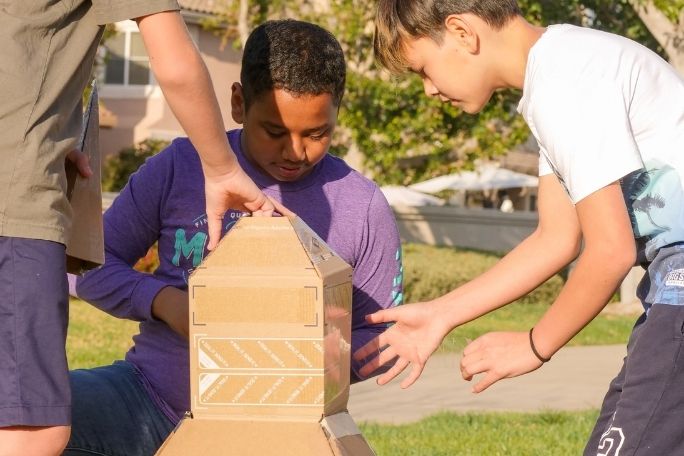Lesson Summary
Students use design thinking to guide their work in creating an upcycled cardboard design. Students identify a user and their needs and then ideate and prototype a design that can be shared with the user.
Learning Intentions:
Students will...
- understand why upcycling can improve the recycling loop
- create a furniture solution to address a need identified by another student.
Success Criteria:
Students can...
- choose and justify a design and features for a piece of furniture made from cardboard
- experiment with and apply construction techniques to create their piece of furniture
- critically evaluate and reflect on their work.
Lesson guides and printables
Curriculum links
Select your curriculum from the options below.
Lesson details
Curriculum Mapping
Content descriptions:
Year 5 & 6 Design and Technology:
- investigate needs or opportunities for designing, and the materials, components, tools, equipment and processes needed to create designed solutions (AC9TDE6P01)
- generate, iterate and communicate design ideas, decisions and processes using technical terms and graphical representation techniques, including using digital tools (AC9TDE6P02)
- select and use suitable materials, components, tools, equipment and techniques to safely make designed solutions (AC9TDE6P03)
Syllabus outcomes: ST3-14BE, ST3-15I, ST3-16P, ST3-5WT.
General capabilities: Critical and Creative Thinking, Personal and Social Capability.
Cross-curriculum priority: Sustainability.
Relevant parts of Year 5 & 6 achievement standards: Students explain how social, ethical, technical and sustainability considerations influence the design of solutions to meet a range of present and future needs.
Resources Required
- A device capable of presenting a video to the class (optional)
- Design Thinking Image
- Sticky tape, water-based glue or other materials that can be used as an adhesive (alternatively, if you have access to any Make.Do resources these could also be useful). If possible, try to use adhesive materials that can be reused, composted or recycled
- Student Design Workbook
- Students should collect several large cardboard boxes each. You could also keep an eye out for packaging boxes from your school - those that come around flat-pack furniture or white goods are particularly useful. These pieces of cardboard will be used to make the final pieces
You will also need some smaller pieces of card (such as the cardboard you might use to make gift cards). These will be used to create the prototypes.
Skills
This lesson is designed to build students’ competencies in the following skills:
- problem Finding
- problem solving
- empathy
- critical thinking
Additional Info
Level of teacher scaffolding: Medium - Support students in independent work.
Teaching Time: 50 minutes.
This lesson has been developed in partnership with Visy. For over 70 years Visy has been committed to finding sustainable solutions for Australia and New Zealand’s recyclables and helping to reduce local landfills. Visy collects, receives and sorts paper, cardboard, glass, plastics, steel and aluminium from households, businesses and schools with the purpose of reusing these products in the re-manufacture of new packaging products.
Related Professional Learning
Teach the Big Picture of Sustainability
Quick summary: Open your students’ minds to how different systems – environmental, social and economic – are connected. I


Welcome back!
Don't have an account yet?
Log in with:
Create your free Cool.org account.
Many of our resources are free, with an option to upgrade to Cool+ for premium content.
Already have an account?
Sign up with:
By signing up you accept Cool.org's Terms and Conditions(Opens in new tab) and Privacy Policy(Opens in new tab).